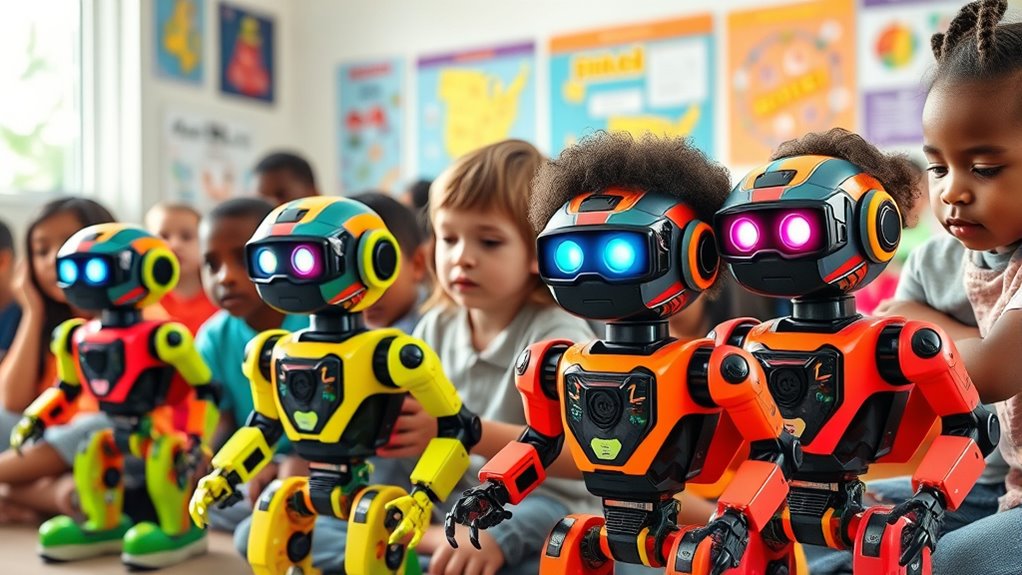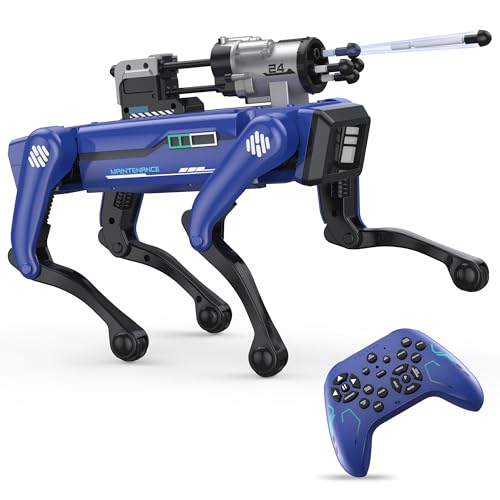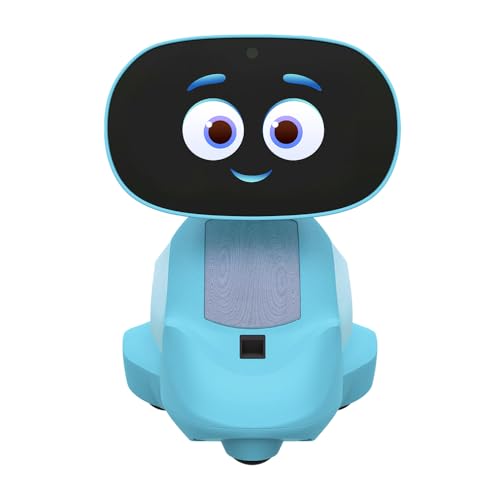I’ve explored some of the top interactive STEM robots that make learning fun and engaging for kids. These include versatile models with voice, app control, sensors, and expressive features that promote creativity, coding, and problem-solving. They suit different ages from preschoolers to tweens, combining play with educational growth. If you want to discover the best options and what makes each unique, keep going—there’s plenty to explore in this exciting field.
Key Takeaways
- Highlights a diverse selection of STEM robots with interactive features like coding, sensors, and expressive actions for engaging learning experiences.
- Includes robots suitable for various ages, from early childhood to teens, promoting age-appropriate STEM skills.
- Emphasizes durability, safety, and design quality to ensure long-lasting, safe play and educational use.
- Features robots with multiple control options—app, voice, gestures, remote—for versatile, hands-on interaction.
- Showcases robots that foster creativity, problem-solving, coding, and artistic expression, making STEM learning fun and engaging.
Smart Robot Dog with Voice & Remote Control for Kids 6-12
If you’re looking for an engaging STEM robot for kids aged 6-12, the Smart Robot Dog is an excellent choice because it combines lifelike movements with simple programming features that promote creativity and learning. This robot can perform over 30 actions, like handstands, swimming, and sleeping, making playtime exciting. Its design includes LED eyes, sound effects, and playful barks that captivate children. Easy to operate right out of the box, it supports USB-C fast charging for quick setup and long-lasting fun. With a remote control range of 25 meters and programmable sequences, kids can develop coding skills while enjoying an interactive, safe, and durable companion.
Best For: kids aged 6-12 who enjoy interactive, educational, and fun robotic toys that promote creativity and motor skills.
Pros:
- Over 30 lifelike actions and sound effects enhance engagement and playfulness.
- Supports programmable sequences and voice control, fostering early coding skills.
- Durable, safe design with impact-resistant materials and auto-shutoff for peace of mind.
Cons:
- Requires 3 AAA batteries for the remote (not included), which may be an extra cost.
- Limited to a 25-meter control range, potentially restricting outdoor play.
- Not as advanced as high-tech robots, so it may lack complex programming capabilities.
Dash Robot, Voice-Activated STEM Robot for Kids 6
The Dash Robot stands out as an ideal choice for children aged 6 and up who are just beginning to explore coding and robotics. Its sturdy, sleek design and smooth motors handle obstacle navigation and different terrains easily. With voice activation, kids can control Dash through simple commands, making learning interactive and fun. It supports multiple apps like Blockly and Wonder, gradually teaching coding concepts such as loops, sequences, and variables. Durable and responsive, Dash is used worldwide in over 40,000 schools. Its engaging features—like singing, dancing, and obstacle navigation—encourage creativity and STEM skills, making it a versatile tool for both classroom and home learning.
Best For: children aged 6-11 who are beginning to explore coding, robotics, and STEM learning at home or in the classroom.
Pros:
- Durable, high-quality build with smooth responsive motors for obstacle navigation.
- Voice-activated controls and multiple educational apps support progressive learning.
- Long-lasting battery life of up to 5 hours and versatile features like singing and dancing enhance engagement.
Cons:
- Does not include a camera, limiting some advanced interactive capabilities.
- Some users have experienced minor mechanical faults or issues with charging cables.
- Lacks features like account sign-up or data tracking, which could be beneficial for progress monitoring.
Learning Resources Cooper the STEM Robot for Kids
Learning Resources Cooper the STEM Robot stands out as an excellent choice for parents, teachers, and caregivers seeking a screen-free way to introduce young children to coding and problem-solving. I love that it’s designed for kids aged 5 and up, offering hands-on learning through physical buttons, coding cards, and sensors. Its bright, friendly design makes complex concepts accessible and fun, while different modes like obstacle avoidance and line tracking keep children engaged. With features like singing, dancing, and multiple robots communicating, Cooper encourages creativity and critical thinking. Plus, its durable build and rechargeable battery make it a practical, long-lasting tool for classrooms and home use alike.
Best For: parents, teachers, and caregivers seeking a fun, screen-free way to introduce children aged 5+ to coding, problem-solving, and STEM concepts through hands-on play.
Pros:
- Encourages early coding and critical thinking with physical buttons and coding cards
- Durable, kid-friendly design with engaging features like singing, dancing, and sensors
- Supports collaborative play and multiple robots for extended learning fun
Cons:
- Some children may lose interest over time without new activities
- Requires adult guidance initially to maximize learning and safety
- Limited digital features, which might be less appealing for tech-focused preferences
Smart Robot Dog with Voice Control and App Programming for Kids
Looking for a robot that combines fun with educational value? The Smart Robot Dog is perfect for kids 6 and up. It performs over 30 lifelike actions, like dancing, barking, and even humorous pee pranks. Controlled by voice commands, a touchscreen app, or a remote, it’s easy to operate. Kids can also use the app to create custom actions and learn basic coding through its programming mode. Made from safe, durable materials, it offers hours of entertainment while encouraging creativity and STEM skills. With fast charging and a long battery life, this robot makes learning interactive and engaging for young tech enthusiasts.
Best For: kids aged 6 and above who enjoy interactive play, creative learning, and basic coding education through a fun, durable robot dog.
Pros:
- Offers over 30 lifelike actions and tricks, providing engaging entertainment
- Supports multiple control methods including voice commands, app programming, and remote for versatility
- Promotes STEM learning with a coding mode that encourages creativity and logical thinking
Cons:
- Requires a smartphone or tablet for full programming features, which may limit play for some users
- Battery life, while sufficient for several hours, may need frequent recharging during extended play sessions
- Some users might find the setup process or app navigation initially challenging for younger children
Drawing Robot for Kids Montessori Painting Toys
A drawing robot designed for kids offers an engaging way to spark creativity and develop fine motor skills in young children. This Montessori-inspired toy encourages hands-on play, artistic confidence, and problem-solving. It comes with 100 themed drawing cards featuring animals, nature, food, and objects, along with colorful pens, markers, and a reusable drawing board. The voice-interactive machine, paired with cheerful music, keeps kids focused and makes drawing fun. Perfect for ages 3-8, it promotes artistic growth, cognitive skills, and independence, making it an ideal gift that combines education and entertainment for budding young artists.
Best For: parents and educators seeking an engaging, educational toy to foster creativity, fine motor skills, and independent learning in children aged 3-8.
Pros:
- Encourages artistic confidence and problem-solving with guided drawing activities.
- Includes a variety of themed drawing cards and colorful art supplies for endless creative possibilities.
- Voice-interactive feature with cheerful music enhances focus and makes drawing fun.
Cons:
- May require adult supervision for younger children to ensure proper use of electronic components.
- Some children might need time to become familiar with the interactive features and drawing process.
- The electronic components and accessories may be susceptible to damage if not handled carefully.
Miko 3 AI-Powered Smart Robot for Kids
The Miko 3 AI-Powered Smart Robot is an excellent choice for parents seeking an engaging, versatile companion that combines education and entertainment for children aged 5 to 12. It features a touchscreen for interactive adventures, supports STEAM learning with content from Disney and others, and offers games, stories, and activities. Miko 3 promotes active play with movement-based games like Freeze Dance and Hide & Seek, using sensors and a HD camera. Its deep-learning AI personalizes interactions, increasing engagement, while its durable design guarantees safe, long-lasting play. Many kids develop strong bonds with Miko 3, making learning fun and emotionally enriching.
Best For: parents seeking an interactive, educational, and entertaining robot companion for children aged 5-12 to foster curiosity, learning, and emotional connection.
Pros:
- Offers personalized interactions with deep-learning AI that increases engagement by 55%
- Combines educational content with fun activities across STEAM subjects supported by popular entertainment brands like Disney
- Durable, portable design with safety features suitable for active play and travel
Cons:
- Short battery life (around 4-5 hours) and rapid battery drain reported by some users
- Limited parental controls in the free version and occasional connectivity or responsiveness issues
- Voice recognition limitations in non-English languages and occasional unintended power-ons
Power Your Fun Robo Pets Unicorn Toy for Kids
Power Your Fun Robo Pets Unicorn Toy is an excellent choice for kids aged 3 and up who love interactive, programmable toys. It neighs, prances, dances to music, performs tricks, and navigates rooms using sensors. Kids can guide it with gestures, program sequences in Treat Mode, or enjoy autonomous adventure mode. Its LED eyes light up with excitement, making each play session engaging. This award-winning STEM toy promotes basic programming skills, teaching sequencing and cause-effect relationships through fun activities. Built with safe, high-quality materials, it offers about 40 minutes of play per charge. Despite some remote control issues, many users find it a delightful, educational toy that fosters creativity and problem-solving.
Best For: children aged 3 and up who enjoy interactive, educational, and programmable robotic toys that combine fun with STEM learning.
Pros:
- Engages kids with multiple interactive modes including gestures, tricks, dancing, and autonomous navigation.
- Promotes basic programming skills through sequencing activities and cause-effect learning.
- Made from high-quality, safe materials with approximately 40 minutes of play per charge, ensuring safe and extended fun.
Cons:
- Remote control buttons can be difficult for small children to press comfortably.
- Some users report issues with remote control durability and occasional technical malfunctions.
- Wheels may get hair entangled or sustain damage when used on carpets, requiring careful handling.
Holyton 5088 Smart Robots for Kids
If you’re looking for an engaging STEM robot that combines programming, interaction, and fun, Holyton 5088 stands out as a top choice for kids aged 6 to 15. Standing 15.7 inches tall, it’s built from safe, skin-friendly ABS plastic with smooth edges, ensuring safe play. With features like LED eyes, a gripping arm, soft-bullet launcher, and colorful design inspired by popular characters, it appeals to kids of all genders. The robot responds to multiple control modes—remote, Bluetooth app, and tilt—plus 11 voice commands. Its programmable actions, dance modes, and interactive functions make learning coding and logic fun and accessible, keeping kids engaged for hours.
Best For: kids aged 6 to 15 who enjoy interactive STEM toys that combine programming, coding, and imaginative play.
Pros:
- Engaging and educational, promoting STEM learning through programmable actions and voice commands
- Safe, skin-friendly materials with rounded edges suitable for children
- Multiple control modes (remote, app, tilt) for versatile and intuitive play
Cons:
- Minor durability issues reported, such as broken missile ports or build quality concerns
- Some users mention that certain components may require careful testing upon receipt
- Limited battery life during extended play sessions due to internal rechargeable batteries
Bottleboom STEM 13-in-1 Solar Power Robot Toys for Kids
Designed for children aged 8 to 12 who love hands-on learning, Bottleboom STEM 13-in-1 Solar Power Robot Toys stands out as an engaging way to explore robotics and renewable energy. This kit lets kids build 13 different models, from animals to vehicles, using safe, non-toxic parts. Powered by solar energy, these robots move on land or water, promoting sustainability and STEM skills. While assembly can be tricky and some parts fragile, the detailed instructions and variety of models keep children motivated. It’s a fun, educational tool that encourages creativity, problem-solving, and understanding renewable energy concepts in a hands-on way.
Best For: children aged 8-12 who enjoy hands-on STEM activities, robotics, and renewable energy projects.
Pros:
- Encourages STEM learning, creativity, and problem-solving skills through building various models.
- Powered by solar energy, promoting awareness of renewable resources and sustainability.
- Made from safe, non-toxic materials suitable for children and offers multiple models to keep kids engaged.
Cons:
- Assembly can be complex and may require adult assistance, especially for younger children.
- Some parts, such as gears or solar batteries, may be fragile or arrive damaged, affecting functionality.
- Instructions may be confusing or poorly written, leading to difficulties during assembly and potential frustration.
BIRANCO Unicorn Robot Toy for Girls 3-6 Years Old
The BIRANCO Unicorn Robot Toy is an excellent choice for parents seeking an engaging STEM toy for young girls aged 3 to 6. It features a colorful unicorn that walks, neighs, dances, and reacts with lights and sounds, making playtime exciting. Kids can style its mane with the included comb, encouraging creativity and fine motor skills. With gesture sensing and programming modes, children can control or create sequences of up to 30 moves, fostering problem-solving and sequencing skills. Its autonomous adventure mode avoids obstacles, promoting independent play. Rechargeable and durable, it offers hours of safe, educational fun suitable for birthdays or holidays.
Best For: young children aged 3 to 6 who enjoy interactive, educational, and imaginative play with STEM-inspired features.
Pros:
- Encourages creativity, fine motor skills, and problem-solving through styling and programming.
- Offers multiple modes including gesture sensing, programming, and autonomous adventure for varied play experiences.
- Rechargeable design and durable materials ensure long-lasting, safe entertainment.
Cons:
- Remote control requires 2 AAA batteries, which are not included.
- Some users have experienced minor glitches or technical malfunctions.
- Higher price point compared to simpler toy unicorns, which may be a consideration for budget-conscious buyers.
LEXiBOOK Powerman Jr. Interactive Robot Toy for Kids
Lexibook Powerman Jr. stands out as an excellent choice for young children aged 3 and up who love interactive and educational toys. This friendly green/blue robot dances, plays music, reproduces animal sounds, and interacts through a remote control. Kids can enjoy guessing games, program up to 40 actions, and record funny messages, promoting creativity and learning about animals and the environment. Its durability and engaging features make it a popular gift, especially for kids with special needs. While some users note slow responses and remote issues over time, overall, Powerman Jr. offers a fun, educational experience that keeps children entertained and inspired to explore STEM concepts.
Best For: children aged 3 and above who enjoy interactive, educational toys that promote creativity, learning, and environmental awareness.
Pros:
- Engaging features like dancing, singing, animal sounds, and programming encourage creativity and STEM skills
- Educational content and environmental themes support learning about animals and biodiversity
- Durable design and positive customer feedback highlight its entertainment value and reliability
Cons:
- Response speed can be slow, which may affect play experience
- Remote control functionality may diminish over time, leading to potential usability issues
- Limited options in the animal guessing game and some users find it overpriced for the features offered
Makeblock Codey Rocky Emo Robot for Kids 6
If you’re looking for a beginner-friendly STEM robot that combines emotional expression with versatile coding options, Makeblock Codey Rocky Emo Robot for Kids 6 is an excellent choice. This panda-shaped robot is designed for kids aged 6 and up, offering engaging sound effects and expressive emotions like smiling and anger. It’s ready to play right out of the box, supporting remote control, beginner coding with Scratch, and building block compatibility for endless creativity. Its impact-resistant build guarantees durability during active play. Perfect for home or classroom use, it promotes problem-solving, logical thinking, and emotional intelligence while making learning fun and interactive.
Best For: parents, teachers, and kids aged 6 and above seeking an engaging, beginner-friendly STEM robot that fosters emotional development, creativity, and coding skills.
Pros:
- Supports multiple coding modes including Scratch, Python, and remote control for versatile learning.
- Features expressive emotions and sound effects that enhance emotional intelligence and engagement.
- Durable, impact-resistant design suitable for active use in both home and classroom environments.
Cons:
- May require additional accessories or updates for advanced coding features.
- Limited to beginner and intermediate coding levels, not ideal for highly advanced programmers.
- The panda-shaped design might not appeal to all children’s preferences.
Elenco Teach Tech Zivko The Robot Interactive A/I Robot with Infrared Sensor
Designed for children aged 10 and up, the Elenco Teach Tech Zivko The Robot stands out with its AI capabilities and infrared sensors, making it an excellent choice for young learners interested in hands-on robotics. Zivko allows kids to build their own robot, fostering mechanical engineering skills through assembly and experimentation. Its infrared sensors enable it to navigate obstacles, follow movement, and switch between “Follow” and “Explore” modes, introducing concepts of artificial intelligence. With engaging sound and light effects, Zivko makes learning STEM fun and interactive, encouraging problem-solving, curiosity, and practical understanding of robotics and technology.
Best For: Young learners aged 10+ who are interested in hands-on robotics, STEM education, and exploring artificial intelligence through engaging, interactive activities.
Pros:
- Promotes STEM learning with practical assembly and experimentation
- Introduces AI concepts through obstacle navigation and mode switching
- Enhances problem-solving, critical thinking, and curiosity in a fun way
Cons:
- May require adult supervision during assembly for younger children
- Limited to basic AI features, which might not satisfy advanced robotics enthusiasts
- Assembly process could be challenging for some beginners without prior experience
Upgraded Drawing Robot for Kids
Looking for a screen-free way to spark your child’s creativity and improve their fine motor skills? The Upgraded Drawing Robot for Kids is perfect. Designed for ages 3-10, it features improved card recognition for better focus and engagement. It reads aloud objects from a set of 100 cards, plays music, and guides kids step-by-step, encouraging artistic exploration. No app needed—just simple controls and voice narration. With over 3 hours of playtime, it helps develop hand-eye coordination, concentration, and creativity. Compact and lightweight, this robot makes a fun, educational gift that turns drawing into an interactive, screen-free experience kids will love.
Best For: parents and educators seeking a screen-free, interactive way to foster creativity and fine motor skills in children aged 3-10.
Pros:
- Encourages artistic exploration and imagination without the need for screens or apps.
- Improves focus, hand-eye coordination, and fine motor skills through guided drawing activities.
- Compact, lightweight design with a complete set of drawing tools and over 3 hours of playtime for versatile use.
Cons:
- Higher price point (~$66) may be a barrier for some buyers.
- No volume control, which can lead to loud sound output during use.
- Occasional drawing inaccuracies and loose pens may require adjustments for optimal performance.
Drawing Robot for Kids with 150 Cards
The Drawing Robot for Kids with 150 Cards is an excellent choice for parents and educators seeking an engaging, screen-free way to nurture creativity and fine motor skills in children aged 3-8. It features voice-interactive functions, guided drawing, and themed cards that teach animals, objects, letters, and scenes. The robot helps children develop hand-eye coordination, patience, and problem-solving while fostering artistic growth. With easy setup, colorful markers, and step-by-step instructions, it keeps kids focused and entertained. This durable, adorable toy makes learning fun and promotes independent exploration, making it a perfect gift for sparking creativity in young learners.
Best For: parents and educators seeking a fun, screen-free educational toy that promotes creativity, fine motor skills, and independent learning in children aged 3-8.
Pros:
- Engaging voice-interactive features and guided drawing instructions that foster creativity and focus.
- Includes a comprehensive set of 150 themed cards, markers, and drawing tools for endless inspiration.
- Durable, adorable design suitable for young children, making it an ideal gift for birthdays and holidays.
Cons:
- Occasional misalignment or incomplete strokes during drawing may require adjustments.
- Requires a 5V/2A adapter for charging, which is not included and may need to be purchased separately.
- Some children might need initial supervision during setup or to ensure proper use of the drawing tools.
Factors to Consider When Choosing Interactive STEM Robots for Kids

When selecting an interactive STEM robot, I always keep in mind factors like age appropriateness and educational value to guarantee it’s suitable and engaging. I also consider durability, safety, and the complexity of programming to match the child’s skills and prevent frustration. Finally, I look at control options to make sure it’s easy and fun for kids to operate and learn from.
Age Appropriateness
Choosing the right interactive STEM robot for your child depends heavily on their age and developmental stage. It’s vital to confirm the robot’s recommended age matches your child’s abilities to promote safe, appropriate learning. For ages 3-6, opt for robots with simple controls, basic movements, and sensory features that engage their curiosity without overwhelming them. For older children, ages 7-12, select robots with more advanced programming, problem-solving tasks, and multi-step activities that challenge their growing skills. Also, consider the complexity of the interface and functionalities to match their ability to operate independently. Safety features are essential too—look for age-specific small parts and sturdy construction, especially for energetic or curious kids. Matching the robot to your child’s age helps foster engagement and confidence.
Educational Value
Evaluating the educational value of STEM robots involves examining how effectively they teach key concepts like coding, engineering, and problem-solving through hands-on activities. I look for robots that incorporate age-appropriate challenges with increasing difficulty to promote ongoing learning and skill growth. Interactive features, such as voice commands, programmable actions, and sensors, boost engagement while reinforcing STEM principles. High-quality robots often align with curriculum standards, ensuring their relevance both at home and in the classroom. I also consider whether the robot encourages critical thinking, creativity, and independent exploration, as these qualities deepen understanding of STEM topics. Ultimately, a robot’s educational value hinges on its ability to make complex concepts accessible and exciting, fostering curiosity and long-term interest in STEM fields.
Durability and Safety
Ensuring durability and safety is essential when selecting interactive STEM robots for kids, as active play can lead to wear and tear or potential accidents. I recommend choosing robots made from non-toxic, BPA-free, impact-resistant materials with smooth edges to prevent injuries. It’s also important to look for safety certifications like FCC, CE, or CPC, which confirm the product meets established safety standards. Features such as auto-shutoff or collision detection help protect internal components and motors from damage, extending the robot’s lifespan. The robot’s size and weight matter too—sturdy enough to withstand falls and rough handling without breaking. Ultimately, secure battery compartments and charging ports prevent accidental access to electrical parts, ensuring safe, worry-free play.
Programming Complexity
When selecting an interactive STEM robot for kids, understanding its programming complexity is essential because it determines how easily children can learn and enjoy coding. Some robots feature simple button controls, making them perfect for beginners, while others require knowledge of advanced languages like Python or JavaScript. For younger or less experienced kids, visual programming tools like Blockly or Scratch simplify coding, making it accessible and fun. More advanced robots may involve understanding concepts like algorithms, loops, variables, and conditionals, which can challenge older or more skilled children. Many robots offer modular programming, allowing kids to start with basic commands and gradually progress to more complex coding as their skills grow. Matching complexity to a child’s age and ability ensures an engaging and frustration-free learning experience.
Control Options
Choosing the right control options for a STEM robot can make a big difference in how kids learn and have fun. I look for robots that offer multiple control methods, like voice commands, remote controls, or app-based controls, to match different learning styles. It’s important that the control range is sufficient—usually 10 to 25 meters—for both indoor and outdoor play. Ease of use is vital; controls should be intuitive and age-appropriate, so kids can operate them confidently. I also consider whether the controls support progressive learning, allowing children to start with simple commands and advance to programming or app interactions. Ultimately, compatibility with devices and operating systems ensures seamless control, whether using a smartphone, tablet, or dedicated remote.
Interactive Features
Interactive features like voice recognition, motion sensors, and programmable actions play a vital role in making STEM robots engaging and fun for kids. These features enable children to communicate easily with the robot and control it through various methods, fostering a sense of connection. Sound effects, LED lights, and responsive movements create a more immersive experience, stimulating sensory development and making playtime more enthralling. Many robots offer multiple control modes, such as remote control, app-based programming, gesture sensing, and voice commands, accommodating different learning preferences. The ability to record and playback custom sequences encourages creativity and helps develop sequencing and logical thinking skills. Overall, these interactive elements promote curiosity, problem-solving, and active participation, making STEM learning both enjoyable and impactful.
Price and Budget
Finding the right STEM robot for your child starts with considering the overall cost, including accessories, programming apps, and potential upgrades. I recommend comparing price ranges across different models to find a balance between affordability and essential features like durability and interactivity. Setting a clear budget beforehand helps prevent overspending on unnecessary features that may not match your child’s current skill level. Keep in mind that higher-priced robots often provide more advanced coding capabilities, longer battery life, and extra educational content, which can be beneficial long-term. However, budget-friendly options might have limited functionality or durability, so it’s important to weigh the cost against value and safety. Being mindful of these factors ensures you choose a robot that offers the best learning experience within your budget.
Frequently Asked Questions
How Do Interactive STEM Robots Enhance Kids’ Problem-Solving Skills?
Interactive STEM robots boost kids’ problem-solving skills by encouraging hands-on experimentation and critical thinking. I’ve seen how children troubleshoot, debug, and adapt as they program or guide the robots, learning from mistakes along the way. These activities promote resilience and creativity, making problem-solving engaging and fun. Plus, the immediate feedback from robots helps kids understand concepts better and develop confidence in tackling complex challenges.
Are These Robots Suitable for Children With Special Needs?
Absolutely, these robots can be suitable for children with special needs. I’ve seen a case where a child with autism used a programmable robot to improve social skills and communication. The robot’s predictable responses and engaging activities provide a safe, supportive environment. I recommend choosing models with customizable features and sensory options to meet individual needs, ensuring a positive, inclusive learning experience for every child.
What Safety Features Are Included in These STEM Robots?
These STEM robots come with several safety features to keep kids secure and happy. I’ve seen models with rounded edges to prevent injuries, soft materials that are gentle to touch, and sturdy builds that resist breaking. Many also have secure, tamper-proof batteries and sensors that stop the robot if it detects obstructions. Overall, I find these safety measures reassuring, making the learning experience both fun and worry-free for children.
Can These Robots Be Connected to Other Educational Devices?
Yes, many of these STEM robots can connect to other educational devices. I’ve seen models that sync with tablets, computers, and even smartboards, allowing for seamless integration into classroom activities or home learning. This connectivity enhances the interactive experience, making lessons more engaging. Just make sure to check the compatibility specifications before purchasing to guarantee the robot will work well with your existing devices.
How Long Does the Battery Typically Last During Continuous Play?
Did you know that most interactive STEM robots usually last about 1 to 2 hours during continuous play? In my experience, battery life varies depending on the model and activity level. Typically, you can expect around 90 minutes of fun, but some advanced robots with larger batteries can last up to 2 hours. I recommend keeping a charging station nearby so the learning never has to pause!
Conclusion
Choosing the perfect STEM robot is like finding a trusty sidekick for your child’s learning adventure. Each one brings a unique spark of curiosity and fun to the table, turning education into an exciting journey through a wonderland of discovery. So, pick the one that lights up your kid’s imagination and watch as they transform into little inventors and explorers. After all, the right robot can make learning as thrilling as a rollercoaster ride!
























